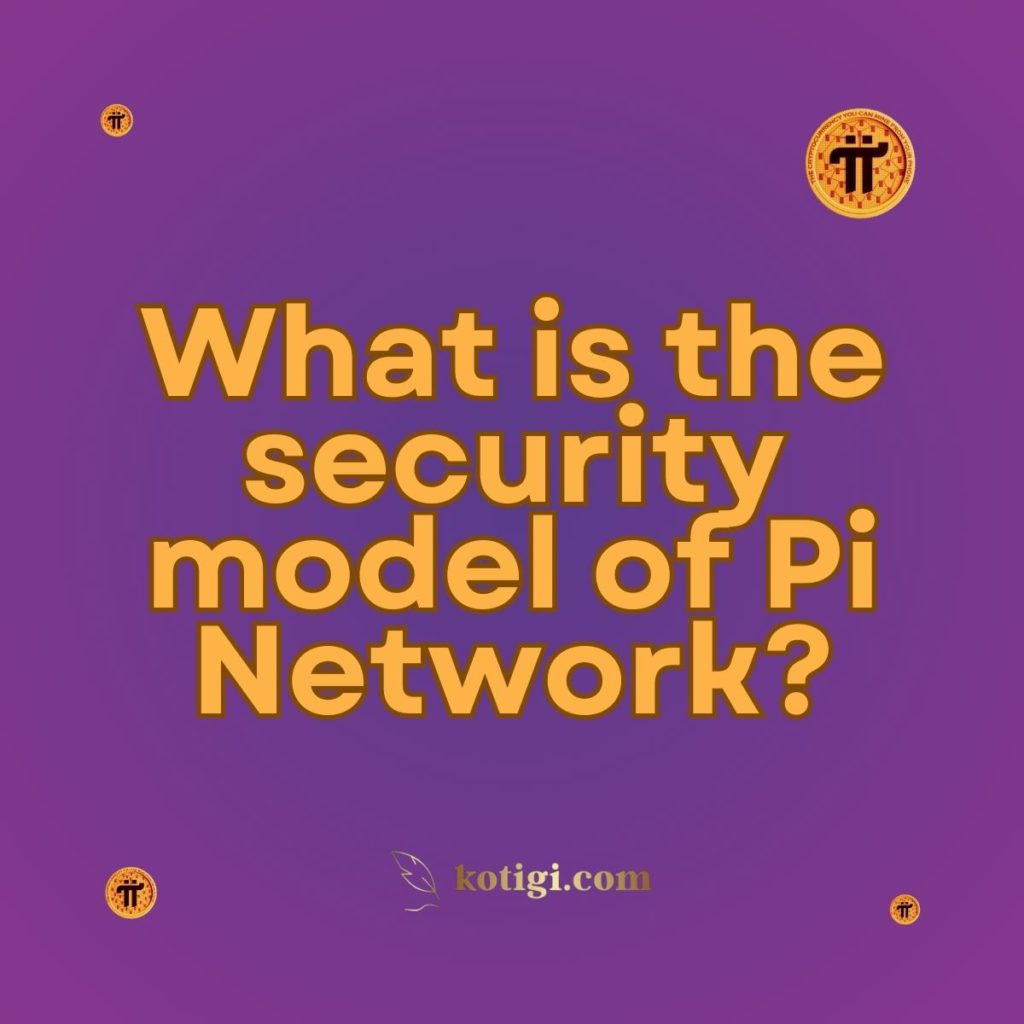
What is the security model of Pi Network?
The security model of Pi Network combines user-centric validation, a unique consensus mechanism, and strong encryption protocols to protect users and their assets. This innovative approach ensures a secure and trustworthy environment for digital currency transactions.
Introduction
In the rapidly evolving world of cryptocurrencies, security remains a paramount concern for users and developers alike. With the rise of digital currencies, hackers have become more sophisticated, targeting platforms that lack robust security measures. Pi Network, launched in 2019, aims to create a secure and accessible platform for digital currency through its innovative security model. By prioritizing user safety and data protection, Pi Network seeks to build trust within its community and foster widespread adoption.
Understanding the security model of Pi Network is crucial for users who want to engage confidently with the platform. This post will explore the key components of Pi Network’s security model, including user-centric validation, consensus mechanisms, encryption practices, and community involvement. By delving into these elements, we can appreciate how Pi Network addresses security challenges and aims to provide a safe environment for its users.
1. Overview of Security in Cryptocurrency
1.1 Importance of Security
Security is critical in the cryptocurrency space due to the potential for hacks, fraud, and loss of assets. A robust security model not only protects users but also enhances the credibility of the network. Without a solid security framework, users may hesitate to adopt a platform, fearing for their financial assets and personal information.
1.2 Common Security Threats
Common threats in the cryptocurrency ecosystem include:
- Phishing Attacks: Deceptive attempts to acquire sensitive information, often through fake websites or emails.
- Double-Spending: Spending the same digital currency more than once, which can undermine the integrity of the currency.
- Smart Contract Vulnerabilities: Exploits within the code of smart contracts that can lead to unauthorized access or loss of funds.
- Malware and Ransomware: Malicious software that can compromise user devices and demand payment for the return of access.
Addressing these issues is essential for the long-term success of any cryptocurrency. Users must feel secure in their transactions and confident that their investments are protected.
1.3 Regulatory Challenges
Cryptocurrencies must navigate complex regulatory environments, which can pose additional security challenges and compliance requirements. Regulations vary by region and can change rapidly, making it vital for platforms like Pi Network to remain adaptable and compliant.
2. User-Centric Validation
2.1 Role of Community Validation
Pi Network emphasizes community validation as a core component of its security model. Users are encouraged to validate each other’s transactions, fostering a decentralized approach to trust. This model not only enhances security but also creates a sense of community among users.
2.2 Building a Trust Network
By utilizing social connections for validation, Pi Network creates a trust network that reduces the likelihood of fraudulent activities. Users are more likely to engage in secure transactions with known contacts, thereby creating a self-regulating environment.
2.3 Incentives for Validation
Users receive rewards for validating transactions, which motivates participation and strengthens the network’s security. This incentive structure encourages users to actively engage in maintaining the integrity of the platform.
2.4 Risk Mitigation
The community validation approach serves as a risk mitigation strategy. When users know they are accountable to their peers, they are less likely to engage in fraudulent activities.
2.5 Transparency and Accountability
Community validation fosters transparency, as users can easily track and verify transactions. This transparency helps build accountability and trust within the network.
3. Unique Consensus Mechanism
3.1 Stellar Consensus Protocol (SCP)
Pi Network’s consensus mechanism is inspired by the Stellar Consensus Protocol, allowing for quick and efficient agreement on the state of the ledger without the energy-intensive processes seen in traditional mining. This protocol enables the network to reach consensus quickly, ensuring smooth and fast transaction processing.
3.2 Mobile Mining and Consensus
The mobile mining feature allows users to participate in the network’s consensus process, further decentralizing security and increasing user involvement in safeguarding the network. This approach democratizes the mining process, making it accessible to a broader audience.
3.3 Community Consensus
The community consensus mechanism relies on user validation to enhance security and trust within the network. This unique approach ensures that transactions are verified by multiple users, further reducing the risk of fraud.
3.4 Speed and Efficiency
This consensus model significantly increases transaction speed and reduces processing costs compared to traditional mining methods. Faster consensus allows for quicker transaction confirmations, improving the user experience.
3.5 Scalability
The consensus mechanism is designed to scale with the network, accommodating a growing number of users and transactions without compromising security or performance.
4. Encryption Practices
4.1 Data Encryption
To protect user data, Pi Network employs advanced encryption techniques. This ensures that sensitive information remains confidential and secure from unauthorized access. Encryption is a fundamental component of the security architecture.
4.2 Secure Communication Channels
Pi Network utilizes secure communication channels to protect the integrity of transactions and user interactions, reducing the risk of man-in-the-middle attacks. These channels use protocols that encrypt data during transmission, ensuring that information cannot be intercepted.
4.3 End-to-End Encryption
All communication within the network is subject to end-to-end encryption, ensuring that data is only accessible to the intended recipients. This level of encryption is crucial for maintaining user privacy.
4.4 Regular Security Updates
The platform undergoes regular security updates to address vulnerabilities and enhance encryption methods as needed. Staying proactive about security helps mitigate risks associated with emerging threats.
4.5 User Data Protection
User data protection is a top priority. Pi Network implements strict data protection policies to comply with regulations and safeguard user information.
5. Multi-Factor Authentication
5.1 Enhanced User Security
To further protect user accounts, Pi Network employs multi-factor authentication (MFA). This adds an additional layer of security, requiring users to verify their identity through multiple methods, such as SMS codes or authentication apps.
5.2 Reducing Unauthorized Access
MFA significantly reduces the risk of unauthorized access, making it more challenging for malicious actors to compromise user accounts. Users are encouraged to activate MFA to enhance their account security.
5.3 User Education on MFA
Educating users about the importance of MFA and how to set it up is a key part of Pi Network’s security awareness initiatives. Informing users about potential threats can motivate them to adopt stronger security practices.
5.4 Account Recovery Options
Pi Network offers secure account recovery options that ensure users can regain access to their accounts without compromising security. These options are designed to protect user accounts while providing a straightforward recovery process.
6. Continuous Monitoring and Audits
6.1 Ongoing Security Monitoring
Pi Network employs continuous monitoring of its network to identify and respond to potential security threats in real-time. This proactive approach helps maintain a secure environment and allows for rapid response to incidents.
6.2 Regular Security Audits
Regular security audits are conducted to assess the robustness of the network’s security measures. This helps identify vulnerabilities and implement necessary improvements. These audits are crucial for maintaining high security standards.
6.3 Incident Response Drills
The team conducts regular incident response drills to ensure preparedness for potential security breaches. These drills help the team practice their response strategies and refine their protocols.
6.4 Analysis of Monitoring Data
Monitoring data is analyzed to identify patterns or anomalies that may indicate a security threat. This analysis helps inform the development of new security measures.
7. Community Engagement and Education
7.1 User Education Programs
To empower users, Pi Network provides educational resources on security best practices. Educating users about potential threats and safe practices enhances the overall security of the network.
7.2 Community Reporting Mechanisms
Pi Network encourages users to report suspicious activities or potential vulnerabilities. This community-driven approach fosters a culture of vigilance and collective responsibility for security.
7.3 Gamification of Security Training
Incorporating gamified elements in security training makes it more engaging for users to learn about security best practices. Gamification can increase participation and retention of information.
7.4 Collaborations with Cybersecurity Experts
Partnerships with cybersecurity professionals enhance the community’s understanding of security measures and emerging threats. By leveraging expert knowledge, Pi Network can better inform its users.
7.5 Feedback Mechanisms
User feedback is collected to understand security concerns and improve educational initiatives. Listening to the community is essential for creating relevant resources.
8. Response to Security Incidents
8.1 Incident Response Protocols
In the event of a security incident, Pi Network has established protocols to respond swiftly and effectively. This includes communication strategies to inform users and mitigate potential damage.
8.2 Post-Incident Analysis
Post-incident analysis is conducted to learn from security breaches and improve the network’s defenses. Continuous learning is essential for adapting to evolving threats.
8.3 Transparency with Users
After incidents, Pi Network commits to transparent communication with users to maintain trust and inform them of steps taken to improve security. Transparency is key to building community confidence.
8.4 Collaborating with Authorities
In case of significant security incidents, Pi Network collaborates with relevant authorities to ensure a thorough investigation and response. This cooperation strengthens the overall security framework.
9. Legal and Regulatory Compliance
9.1 Adherence to Regulations
Pi Network strives to comply with legal and regulatory requirements related to data protection and user security. This commitment enhances trust and credibility among users.
9.2 Collaborations with Authorities
By collaborating with relevant authorities and cybersecurity experts, Pi Network aims to strengthen its security framework and stay updated on the latest security practices.
9.3 Compliance Audits
Regular compliance audits ensure that Pi Network meets regulatory requirements and maintains high security standards. Compliance is crucial for fostering a secure user environment.
9.4 User Data Management
Compliance with data protection regulations ensures that user data is handled responsibly and ethically. Pi Network prioritizes user privacy in its operations.
10. Future Security Enhancements
10.1 Innovations in Security Technology
As technology evolves, Pi Network is committed to exploring and integrating innovative security solutions to protect its users and assets. Staying ahead of potential threats is vital for maintaining security.
10.2 User Feedback and Adaptation
User feedback plays a crucial role in shaping future security enhancements. By actively listening to the community, Pi Network can adapt its security measures to meet user needs effectively.
10.3 Research and Development
Ongoing R&D efforts aim to identify emerging threats and develop proactive solutions to mitigate risks. Continuous research is essential for staying ahead of potential security challenges.
10.4 Enhancing User Education
Future enhancements will also focus on improving user education programs to raise awareness about security issues. Empowered users are a critical line of defense against threats.
10.5 Collaboration with Tech Innovators
By partnering with technology innovators, Pi Network can leverage cutting-edge solutions to enhance its security infrastructure.
Conclusion
The security model of Pi Network is a comprehensive approach that prioritizes user safety, community involvement, and continuous improvement. By implementing user-centric validation, a unique consensus mechanism, robust encryption practices, and ongoing education, Pi Network aims to create a secure environment for its users. As the cryptocurrency landscape continues to evolve, Pi Network’s commitment to security will play a vital role in building trust and fostering widespread adoption.
Key Takeaways:
| Key Aspect | Description |
|---|---|
| User-Centric Validation | Community validation enhances trust and reduces fraud. |
| Consensus Mechanism | Inspired by Stellar, enabling efficient transaction agreement. |
| Encryption Practices | Advanced encryption ensures data security and confidentiality. |
| Multi-Factor Authentication | Adds an extra layer of security to user accounts. |
| Ongoing Monitoring | Continuous security monitoring helps identify threats in real-time. |





